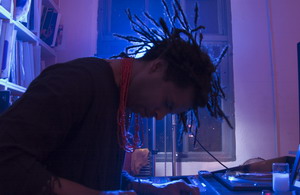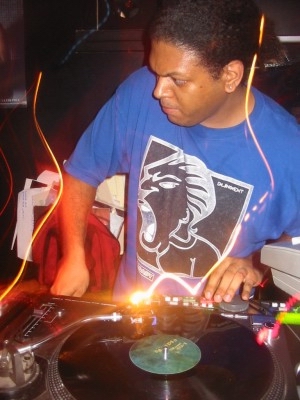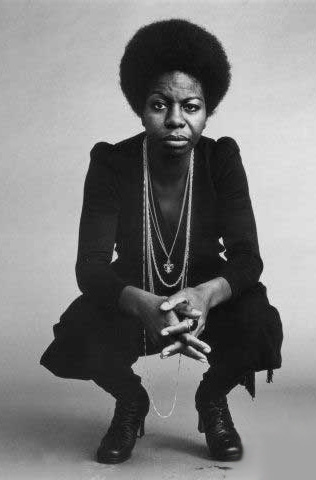NINA SIMONE / “Feelin’ Good” (Joe Claussell Remix)

There’s something subversive about a quality remix of an old record. Case in point: Joe Claussell’s remix of “Feelin’ Good” begins with an electronic groove so lush and graceful that it virtually glides from the speakers. If you’ve never heard this version, the last thing you’ll be thinking is Nina Simone. But when Nina’s voice finally enters the mix—and by then we’re a good two minutes in—the groove and the voice somehow fit with something approaching venerability. Things to listen for: the indolent effortlessness of the between-verses keyboard solo; the disconcerting way Claussell bends and stretches Nina’s voice—technological alchemy at work; and the layers upon layers of synth sounds softening the inevitable harshness of mechanical music-making.

Produced by DJ Kerri Chandler with musician/producer Jerome Sydenham, the so-named ‘Bolshevik’ remix of “See-Line Woman” is based on exactly the sort of skitterish, repetitious house groove that I usually despise. That said, I find this particular skitterish, repetitious house groove irresistible. The snares create a polyrhythmic stair-climbing effect; the flute hovers like a hummingbird above the heaviness of the bass and drums; the archetypal house ‘thump’ is enlivened by not only Nina’s glorious voice but also by the muted, almost inaudible, background chorus intoning, once per measure: “See line!”

Mo' Horizons is a German duo made up of producers/musicians/DJs Ralf Droesemeyer and Mark ‘Foh’ Wetzler. Their version of “Images” is less a remix than it is an entirely new piece of music: a re/deconstruction of a single phrase. Fittingly, the artists renamed their song instead of labeling it a ‘remix.’ The title is taken from the only element common to the two versions: Nina's voice singing, “Dance Naked Under Palm Trees.” One could make an equally good case for Mo’ Horizons being either cheered or chided for what they’ve done, because what they’ve done is turn Ms. Simone’s dark lament into a sly and sensuous inveiglement. Both in sentiment and consummation, these versions are virtually incompatible; as such, the best (the only?) way to hear them is back-to-back.
In all three cases, the remixers have done what all artists set out to do: using their chosen mode of self-expression, they’ve created something beautiful and/or meaningful. Of course, they also had the advantage of exemplary materials which with to work, and by that I mean, well-written and well-performed pieces of music. And of course, that voice. What is strange to me is how attractive it can be to hear Nina Simone’s voice completely out of context. Through varying methodologies, all three remixers give Nina Simone’s voice a new musical partner (21st century electronica) that it never naturally knew. The effect is both strange and wonderful.
—Mtume ya Salaam
Bonus tracks:
“See-Line Woman” (Bolshevik Remix) from Jerome Sydenham And Kerri Chandler Present: Saturdays (Ibadan, 2003)
“Dance Naked Under Palm Trees” from Mo’ Horizons’ Remember Tomorrow (Stereo Deluxe, 2001)
Are producers musicians?
Y'all remember last week when I was talking about Erykah Badu and remixes? The thing about the three remixes under consideration here is precisely what Mtume mentioned: the creators are not contemporaries—indeed Nina is deceased—so we are crossing through eras. Whereas it might have been possible for Opolopo and Badu to work together, that’s no longer the case with Nina. Meaning what? Meaning that collaboration has truly gone into the cyber-world, the other world, a world where you don’t have to be alive to participate in making lively music.
Beyond that is the question of whether electronic music is human, or, put another (and possibly more disturbing) way, can machines make music? If humans are making music using machines (in this case, computers) couldn’t the machines make the music without humans? And, would we recognize the result as music? And, could such music be as acceptable to us as 'real' music, i.e. sounds that are human-made and organized?
Modernism is about using machines to enhance human life. So, within the realm of 21st century music-making, is post-modernism about the self-reflective use of humans to enhance non-human noise-making (where “noise” is just a provocative nomenclature for electronic music, music that is not sensual in the sense that the human sense of touch has not been used to make it)? Electronic music does not require the human touch. You can program a computer to play a synthesizer, to respond to any number of stimulants, from the movement of sunlight in a room, to a random sequence of numbers, to traffic patterns, well, you get the picture.
All of which is to say, what we know as electronic music is enhanced or elevated by the presence of a human as either voice or player of instrument. Thus, these remixes have in common the grit, the texture, the sound of Nina Simone, a sound that is inimitable, unique and fully human. Yet, as you listen to Joe Clausell’s “Feelin' Good” remix we are confronted by something that sounds good even before Nina sounds good.
Or, in the case of Mo' Horizons, Nina’s sampled voice is barely there. So eventually the question is asked: do these mixes really need Nina to be successful?
I think so. But I also recognize that what we call music is changing in ways that music has not changed previously in history. Or to put it in the inverse: are producers musicians? What is a musician?

All of which is to say, as hip as all of these remixes are, without Nina’s presence, without Nina’s reference, none of them would be as effective. Anyway, give thanx, Nina is here, is raised up to another level, a different level (not necessarily a higher level). We are living in a different era and as a result, what we can have is the best of both worlds. Nina as Nina, and, Nina remixed. Mixed or unmixed, or both, I’ll take Nina any which way I can get her.
—Kalamu ya Salaam
This entry was posted on Saturday, October 29th, 2005 at 11:22 pm and is filed under Contemporary. You can follow any responses to this entry through the RSS 2.0 feed. You can leave a response, or trackback from your own site.
4 Responses to “NINA SIMONE / “Feelin’ Good” (Joe Claussell Remix)”
October 30th, 2005 at 5:31 pm
Feeling Good…has a serious Ray Charles vibe to it in the original version…the remix is subtle. I like it. If the goal was to contemporize it, it was reached.
October 30th, 2005 at 6:04 pm
I have ALWAYS loved that Waring Cuney (sp?)poem, so it was a real treat to hear Nina sing it woefully in “Images.” Please let me know where you got that from so that I can use it in my workshops. THANKS!!
October 31st, 2005 at 5:08 am
There’s another remix of Feeling Good that you might be aware of. It’s electronica/rave music that pales next to Joe Clausell’s remix. It is by Huff & Herb. I really appreciate your website. It turns me on to some great music. You also remind me of other music , whether, classic, contemporary or cover. I’m seldom disappointed. I don’t always agree with the critique, but so what. Thanks for the downloads, too. And Kudos for keeping the site alive while you’re going though it in New Orleans, Kalamu; don’t know where Mtume lives.
Mtume says:
I’ve never heard the rave remix of Feelin’ Good, Brandon. Maybe Kalamu has. Has for where I’m living, I’m in San Diego now; but when Katrina hit, I was still living in New Orleans. I wrote about it a few weeks ago. Check it out: Evacuating New Orleans.
Later on…
November 4th, 2005 at 7:47 pm
Todd Terry has also done a remix of Nina’s Feeling Good and in my opinion it’s much better than Joe Clausell’s version.
Leave a Reply
| top |